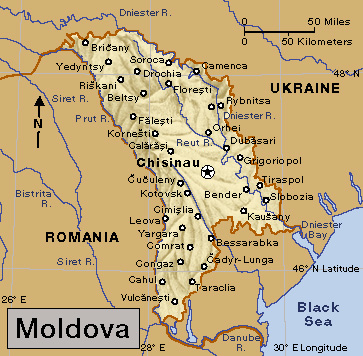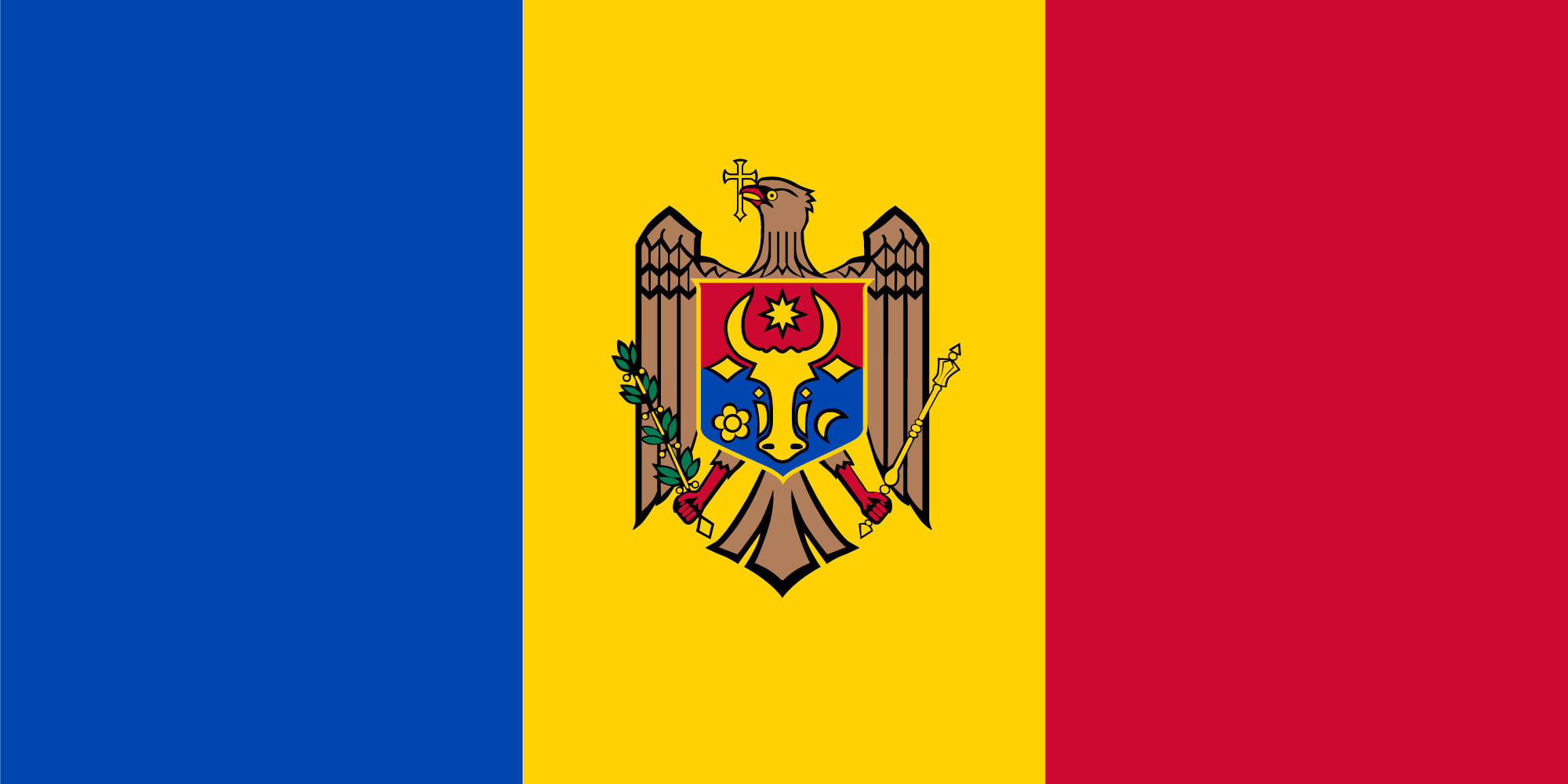Moldova << mawl DOH vuh >> is a country in southeastern Europe. It is bordered by Romania on the west and by Ukraine on the other three sides. Chisinau is Moldova’s capital and largest city.
From 1940 to 1991, Moldova was a republic of the Soviet Union. It was called the Moldavian Soviet Socialist Republic, or simply Moldavia. With the collapse of the Soviet Union in 1991, the republic declared its independence and changed its name to Moldova.

Moldova belonged to Romania before it became part of the Soviet Union. Moldova has especially close ties with a region in eastern Romania that is still called Moldavia. For much of their history, Moldova and the Romanian region of Moldavia were united.
Government.
Political power in Moldova is divided between a president, a Parliament, and a Council of Ministers that is headed by a prime minister. Voters elect the president to a four-year term. Parliament has 101 members, who are elected by voters to four-year terms.

The president selects a prime minister in consultation with Parliament. The prime minister, with the approval of the president and Parliament, selects the members of the Council of Ministers. The council members assist the prime minister in carrying out the functions of government.
The largest political parties have included the Party of Communists of the Republic of Moldova, the Party of Socialists of the Republic of Moldova, and the Liberal Democratic Party of Moldova. Smaller parties occasionally form coalitions to pursue common interests.
People.
About two-thirds of the country’s people are ethnic Moldovans. Most of the rest of the population is made up of Russians; Ukrainians; Gagauz, a Turkic people; and Bulgarians.

More than half of Moldova’s people are rural dwellers. They live clustered in villages, and most of them work as farmers. The official language of the country is Romanian. Most Moldovans are Eastern Orthodox Christians.
Moldovan children are required to attend school from the ages of 6 to 18. Almost every Moldovan 15 years of age or older can read and write. The Moldova State University is in Chisinau. The Academy of Sciences of Moldova in that city oversees the workings of a number of academic institutes.
Land and climate.
Most of Moldova consists of hills broken by river valleys. The highest elevations are in the scenic forests of the central region. The country’s tallest peak is Mount Bālāneşti, which rises 1,407 feet (429 meters) in the Kodry Hills in west-central Moldova. Lush uplands and steppes (grassy plains) cover much of northern and eastern Moldova. A large plain stretches across the southern part of the country.
Moldova has more than 3,000 rivers, but only 8 are longer than 60 miles (95 kilometers). The main waterway is the Dniester River, which flows through eastern Moldova. The Prut River flows along the country’s western border, which separates Moldova from Romania.
Rich, black soil that is good for farming covers much of the country. In the north and along the Dniester, where the most fertile soils are, farmers grow sugar beets, fruits, and some grain. Less rich soils in the southern part of the country are used for growing corn, sunflowers, and wheat. 
The animals found in Moldova include badgers, wild boars, Siberian stags, and wolves. The rivers hold carp, perch, and pike. Such animals as foxes, hares, and muskrats are hunted for their fur.
Temperatures average about 25 °F (–4 °C) in January and about 70 °F (21 °C) in July. The average annual precipitation provides about 20 inches (50 centimeters) of rain, snow, and other forms of moisture.
Economy.
Moldova has a developing economy based heavily on agriculture. The central and southern regions produce grapes for wine. Farms in the south also grow corn and winter wheat. The northern and central regions have fruit orchards and fields of grain. Moldova’s other crops include sugar beets, sunflowers, and tobacco. Dairy farming and cattle, chicken, and hog raising are also important to the economy.
Moldova’s chief industries process food and other agricultural products and manufacture automobile parts, chemicals, clothing and textiles, construction materials, and furniture. The country has few mineral resources, and it must import its coal, natural gas, and petroleum.
Moldova’s chief trading partners include Germany, Italy, Romania, Russia, and Ukraine. The country imports more than it exports. Its main imports include automobiles, machinery, petroleum products, pharmaceuticals (medicinal drugs) and plastics. Its major exports include clothing, fruit and nuts, machinery, vegetables, wheat, and wine.
History.
From about 700 B.C. until about A.D. 200, the region that is now Moldova was under the control of Iranian peoples from central Asia—first the Scythians and later the Sarmatians. From about A.D. 200 until the A.D. 1200’s, various other peoples from the west and east invaded and ruled the area. These invaders included the Goths, Huns, Avars, and finally the Mongols (also called the Tatars).
The people of Moldova gradually united, and by the mid-1300’s, they formed an independent state under a single ruler, a prince. The state was called the principality of Moldavia. It included present-day Moldova, then called Bessarabia, and an area between the northern Carpathian mountain range and the Prut River in modern Romania. For a map showing the principality of Moldavia in 1350, see Romania (History).
Ottoman and Russian rule.
The Ottoman Empire, based in present-day Turkey, gained control of the principality of Moldavia by the early 1500’s. The Ottomans ruled the region until 1812, when Russia took control of Bessarabia. The Treaty of Paris that ended the Crimean War in 1856 gave southern Bessarabia to the principality of Moldavia, following Russia’s defeat in that war. In 1859, the principality of Moldavia and the principality of Walachia, now a region in present-day Romania, elected the same prince. In 1861, their union under the name Romania received international recognition. Russia regained southern Bessarabia in 1878.
Romanian and Soviet rule.
After World War I (1914-1918), all of Bessarabia became part of Romania. The Soviet Union, which had been formed as a Communist state under Russia’s leadership in 1922, refused to recognize Bessarabia’s unification with Romania. In 1924, the Soviets established the Moldavian Autonomous Soviet Socialist Republic (A.S.S.R.) in the Trans-Dniester region, also known as Transdniestria or Transnistria. In 1940, during World War II, the Soviet Union seized Bessarabia. The Soviets merged most of Bessarabia with part of the Moldavian A.S.S.R. to form the Moldavian Soviet Socialist Republic. Bessarabia became part of Romania again in 1941, but the Soviet Union regained it in 1944.
While Moldova was part of the Soviet Union, the Moldovans were forced to use the Cyrillic alphabet instead of the Roman alphabet in writing their language. The Cyrillic alphabet is used to write the Russian language. In 1989, however, the republic’s parliament ordered a return to the Roman alphabet.
From 1940 until the late 1980’s, the Soviet government forbade religious instruction in Moldova and discouraged church attendance. But in 1990, the Soviet Union restored religious freedom.
Breakup of the Soviet Union.
The Moldavian Supreme Soviet, as the legislature of the republic was then called, declared in 1990 that its laws took precedence over those of the Soviet Union. Moldavia also changed its name to Moldova.
In August 1991, conservative Communist officials failed in an attempt to overthrow Soviet President Mikhail S. Gorbachev. During the upheaval that followed, Moldova and several other republics declared their independence. In December, Moldova joined other republics in a loose association called the Commonwealth of Independent States. The Soviet Union was formally dissolved on December 25.
The leaders of independent Moldova restored many of the ties to Romania. They reintroduced Romanian history as a basic subject in the schools and sent thousands of Moldovans to study in Romanian schools. They also adopted the Romanian national anthem.
Threats to Moldovan unity.
In 1990—before Moldova became independent—both the Gagauz people in southern Moldova and Russians and Ukrainians in the Trans-Dniester region in eastern Moldova announced that they were forming independent states. These groups opposed proposals by some Moldovans to reunify Moldova with Romania. In March 1992, fighting broke out in the Trans-Dniester region between ethnic Moldovans and separatists. In July, a peacekeeping force entered the region, and fighting ceased.
In February 1994, Moldova held its first parliamentary elections since declaring independence from the Soviet Union. The Agrarian Democratic Party (later the Agrarian Party of Moldova), which opposed reunification of Moldova and Romania, won a majority of seats. The new government continued negotiations for a permanent settlement in Trans-Dniester. In a nonbinding referendum on reunification held in 1994, most voters supported continued separation from Romania. A new constitution, which became effective in 1994, made Trans-Dniester an autonomous (self-governing) territory.
In parliamentary elections in 1998, Communists won more seats than any other party. But several non-Communist parties joined together in a coalition to form the new government. The Communists gained control of Parliament in elections in 2001.
Recent developments.
In 2009, the Communists lost control of Parliament to a coalition of pro-Western parties. Around this time, Moldova began to lessen its ties with Russia and to increase cooperation with the European Union (EU).
In 2016, Moldova’s Constitutional Court ruled that the president should be directly elected by voters instead of being chosen by Parliament. Later that year, voters elected Socialist Igor Dodon to the presidency. Dodon sought closer relations with Russia.
No party won a majority in February 2019 parliamentary elections. In June, a ruling coalition of pro-European and pro-Russian groups formed in Parliament. Maia Sandu became the new prime minister. The Constitutional Court, however, ruled that the coalition had formed after a court-mandated deadline had passed, and it suspended President Dodon for failing to dissolve Parliament. The court then appointed former prime minister Pavel Filip as temporary president, and Filip called for new elections. These actions sparked mass protests in Moldova and concern among diplomats from Europe, Russia, and the United States. Filip resigned, and Sandu and Dodon returned to office. In November 2019, Ion Chicu succeeded Sandu as prime minister. In 2020, Sandu, running on an anticorruption platform, defeated Dodon in a presidential election. Chicu resigned as prime minster in December, and Aureliu Ciocoi became acting prime minister.
Sandu’s Party of Action and Solidarity won a parliamentary majority in elections held in July 2021. Natalia Gavrilita became prime minister in August.
Moldova faced numerous challenges after Russia invaded Ukraine in 2022. The Moldovan government worked to provide shelter and food for hundreds of thousands of Ukrainian refugees. Russia also reduced natural gas deliveries to Moldova, resulting in higher energy prices. Gavrilita resigned as prime minister in February 2023. Dorin Recean, a former interior minister, was approved as prime minister later that month.
